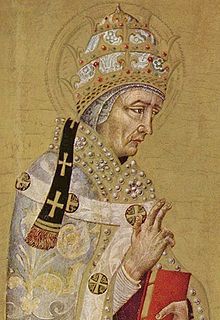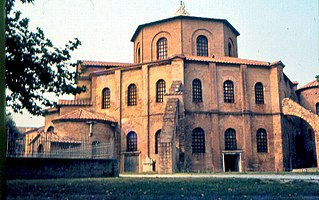Pope Martin I, also known as Martin the Confessor, was the bishop of Rome from 21 July 649 to his death. He served as Pope Theodore I's ambassador to Constantinople and was elected to succeed him as pope. He was the only pope during the Eastern Roman domination of the papacy whose election was not approved by an imperial mandate from Constantinople. For his strong opposition to Monothelitism, Pope Martin I was arrested by Emperor Constans II, carried off to Constantinople, and ultimately banished to Cherson. He is considered a saint and martyr by the Catholic Church and the Eastern Orthodox Church.
Pope Boniface III was the bishop of Rome from 19 February 607 to his death. Despite his short pontificate he made a significant contribution to the Catholic Church.
Pope Gregory II was the bishop of Rome from 19 May 715 to his death. His defiance of Emperor Leo III the Isaurian as a result of the iconoclastic controversy in the Eastern Empire prepared the way for a long series of revolts, schisms and civil wars that eventually led to the establishment of the temporal power of the popes.
Pope Sergius I was the bishop of Rome from 15 December 687, to his death, and is revered as a saint by the Roman Catholic church. He was elected at a time when two rivals, Paschal and Theodore, were locked in dispute about which of them should become pope. His papacy was dominated by his response to the Quinisext Council, the canons of which he steadfastly refused to accept. Thereupon Emperor Justinian II ordered Sergius' arrest, but the Roman people and the Italian militia of the exarch of Ravenna refused to allow the exarch to bring Sergius to Constantinople.

The Second Council of Constantinople is the fifth of the first seven ecumenical councils recognized by both the Eastern Orthodox Church and the Catholic Church. It is also recognized by the Old Catholics and others. Protestant opinions and recognition of it are varied. Some Protestants, such as Calvinists, recognize the first four councils, whereas most Anglo-Catholics and Lutherans accept all seven. Constantinople II was convoked by the Byzantine Emperor Justinian I under the presidency of Patriarch Eutychius of Constantinople. It was held from 5 May to 2 June 553. Participants were overwhelmingly Eastern bishops—only sixteen Western bishops were present, including nine from Illyricum and seven from Africa, but none from Italy—out of the 152 total.

The Third Council of Constantinople, counted as the Sixth Ecumenical Council by the Eastern Orthodox and Catholic Churches, as well by certain other Western Churches, met in 680–681 and condemned monoenergism and monothelitism as heretical and defined Jesus Christ as having two energies and two wills.
Pope Sabinian was the bishop of Rome from 13 September 604 to his death. His pontificate occurred during the Eastern Roman domination of the papacy. He was the fourth former apocrisiarius to Constantinople to be elected pope.
Pope Theodore I was the bishop of Rome from 24 November 642 to his death. His pontificate was dominated by the struggle with Monothelitism.
Pope Vigilius was the bishop of Rome from 29 March 537 to his death. He is considered the first pope of the Byzantine papacy. Born into Roman aristocracy, Vigilius served as a deacon and papal apocrisiarius in Constantinople. He allied with Empress Theodora, who sought his help to establish Monophysitism, and was made pope after the deposition of Silverius. After he refused to sign Emperor Justinian I's edict condemning the Three Chapters, Vigilius was arrested in 545 and taken to Constantinople. He died in Sicily while returning to Rome.
Pope Pelagius I was the bishop of Rome from 556 to his death. A former apocrisiarius to Constantinople, Pelagius I was elected pope as the candidate of Emperor Justinian I, a designation not well received in the Western Church. Before his papacy, he opposed Justinian's efforts to condemn the "Three Chapters" in order to reconcile theological factions within the Church, but later adopted Justinian's position.
Pope Constantine was the bishop of Rome from 25 March 708 to his death. One of the last popes of the Byzantine Papacy, the defining moment of Constantine's pontificate was his 710/711 visit to Constantinople where he compromised with Justinian II on the Trullan canons of the Quinisext Council. Constantine's was the last papal visit to Constantinople until 1967.
Pope John V was the bishop of Rome from 23 July 685 to his death. He was the first pope of the Byzantine Papacy consecrated without prior imperial consent, and the first in a line of ten consecutive popes of Eastern origin. His papacy was marked by reconciliation between the city of Rome and the Empire.

Eutychius, considered a saint in the Catholic and Orthodox Christian traditions, was the patriarch of Constantinople from 552 to 565, and from 577 to 582. His feast is kept by the Orthodox Church on 6 April, and he is mentioned in the Catholic Church's "Corpus Juris". His terms of office, occurring during the reign of Emperor Justinian the Great, were marked by controversies with both imperial and papal authority.
Pope John VI was the bishop of Rome from 30 October 701 to his death. John VI was a Greek from Ephesus who reigned during the Byzantine Papacy. His papacy was noted for military and political breakthroughs on the Italian Peninsula. He was succeeded by Pope John VII after a vacancy of less than two months. The body of the pope was buried in Old St. Peter's Basilica.
An apocrisiarius, the Latinized form of apokrisiarios, sometimes Anglicized as apocrisiary, was a high diplomatic representative during Late Antiquity and the early Middle Ages. The corresponding (purist) Latin term was responsalis. The title was used by Byzantine ambassadors, as well as by the representatives of bishops to the secular authorities. The closest modern equivalent is a papal nuncio; the title apocrisiarius is also still employed by the Anglican Church.

There was no uniform procedure for papal selection before 1059. The bishops of Rome and supreme pontiffs (popes) of the Catholic Church were often appointed by their predecessors or by political rulers. While some kind of election often characterized the procedure, an election that included meaningful participation of the laity was rare, especially as the popes' claims to temporal power solidified into the Papal States. The practice of papal appointment during this period would later result in the jus exclusivae, i.e., a right to veto the selection that Catholic monarchs exercised into the twentieth century.

The Byzantine Papacy was a period of Byzantine domination of the Roman papacy from 537 to 752, when popes required the approval of the Byzantine Emperor for episcopal consecration, and many popes were chosen from the apocrisiarii or the inhabitants of Byzantine-ruled Greece, Syria, or Sicily. Justinian I conquered the Italian peninsula in the Gothic War (535–554) and appointed the next three popes, a practice that would be continued by his successors and later be delegated to the Exarchate of Ravenna.

The Lateran Council of 649 was a synod held in the Basilica of St. John Lateran to condemn Monothelitism, a Christology espoused by many Eastern Christians. The Council did not achieve ecumenical status in either East or West, but represented the first attempt of a pope to convene an ecumenical council independent of the Roman emperor.
The apocrisiarius or apocrisiary was the legate from the pope to the patriarch of Constantinople, circa 452-743, equivalent to the modern nunciature.
Rufius Petronius Nicomachus Cethegus was a politician of Ostrogothic Italy and the Eastern Roman Empire. He was appointed consul for 504, and held the post without a colleague. His father was Petronius Probinus, the consul for 489 and prominent supporter of Antipope Laurentius.






